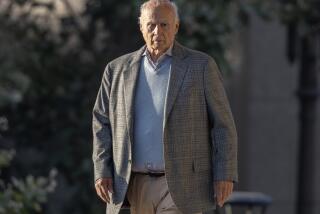Tracing Merrill’s Role in Citron Campaign
- Share via
A top Merrill Lynch trader and other company officials worked behind the scenes during Robert L. Citron’s bitter 1994 election to help the embattled treasurer devise campaign tactics and deflect questions about his risky investment practices, new documents suggest.
Internal Merrill Lynch memos and other documents released over the last weeks show for the first time how Merrill salesman Michael Stamenson attempted to help Citron respond to media queries and defend his record against the attacks of Citron’s opponent, John M.W. Moorlach.
According to the memos, Stamenson offered some questionable advice. For example, he suggested Citron tell the media that he had stopped using new reverse-repurchase agreements even though Stamenson would handle such a transaction a few months later.
Merrill officials declined to comment on the Stamenson advice, referring a reporter to the salesman’s testimony in a civil suit brought by the county against Merrill Lynch.
At the time of Citron’s election battle, other Merrill Lynch officials were developing a defense of the treasurer for a reporter at Forbes magazine.
In an interview, which was never published, Merrill managing director John Kerrigan said Citron’s investment strategies were “on the more conservative end of the risk spectrum.” Kerrigan also downplayed the risks of Citron’s methods, saying, “We’re comfortable with that kind of activity.”
But two months earlier, Merrill executives had told Citron just the opposite--that they were becoming increasingly concerned by the enormous leverage of the county investment pool and the lack of a contingency plan, according to the documents.
Merrill Lynch spokesman Bill Halldin defended Kerrigan’s interview, saying the executive was basing his judgments on Citron’s promise that he would hold his securities to maturity. Halldin pointed out that Kerrigan at one point acknowledged to the Forbes reporter that the pool’s “risk factor had gone up.”
Kerrigan didn’t discuss the firm’s concerns about Citron’s investments, Halldin said, because “the risk of his strategy was well-known due to the Moorlach campaign.”
The company denies that its employees actively aided Citron’s reelection campaign, the spokesman added.
Citron won the election. But his exotic investment schemes caused the county pool to collapse five months later, resulting in a $1.64-billion loss.
The revelations about Merrill’s involvement are contained among thousands of pages of depositions and exhibits collected during the county’s civil case against Merrill Lynch. The two sides settled the lawsuit in June, with the Wall Street giant paying about $437 million.
Campaign Donations
Stamenson and Citron had forged a close relationship over the last decade, but the bond strengthened further in the weeks before the June 1994 election.
Stamenson held no official position with Citron’s campaign and never formally endorsed him. But the broker did make a $1,000 contribution to the treasurer’s reelection campaign in 1993--a day before the Board of Supervisors voted on a bond issue underwritten by his firm.
In all, Merrill executives gave $3,000 to Citron in contributions after the election, a tactic to minimize public notice of the donations, Citron said in testimony.
Citron and his chief assistant, Matthew R. Raabe, sought Stamenson’s counsel after Moorlach released a written critique of the investment pool.
Stamenson agreed to send them a list of “bullet points,” which Citron later testified was a “last-minute, try-to-save-the-election sort of thing.”
Stamenson said during his depositions that the bullet points were his way of helping a client. “[Citron] was explaining to me that he had difficulty keeping his focus when he was [dealing with reporters]. I remember his comment was, ‘The media is like attorneys. They drag you all around.’ ”
Stamenson’s memo included notations that Citron was “downsizing and [had] stopped new reverse-repurchase agreements”--volatile investments that amplified the county’s risks. He also advised Citron to highlight the diversity of the fund’s derivative investments and his policy of holding securities to maturity--meaning their market value never was disclosed.
A few weeks after the election, however, Merrill Lynch commandeered a $600-million taxable note offering for Citron that was later reversed.
In his deposition, Stamenson said he didn’t think his efforts benefited Citron’s reelection campaign. Halldin, the company spokesman, said Stamenson’s bullet points “focused on investments,” not campaign issues, and reflected what the trader believed Citron’s policies were at the time.
But county attorneys disagreed.
“Merrill Lynch became Citron’s press secretary during the campaign,” the county’s attorney, James Mercer, said in a 61-page factual summary of the county’s case released late Thursday.
Forbes Interview
The company also rose to Citron’s defense in mid-April as publicity over Moorlach’s charges circulated through the financial press.
Kerrigan sat down with a reporter for Forbes magazine who asked pointed questions about the amount of risk in the Orange County portfolio.
“If [Citron] levers and it’s appropriate for them and we think it’s appropriate, then most levering is OK,” Kerrigan told Forbes reporter Bob Lenzner.
Two months before Kerrigan issued reassurances to Forbes, three high-level Merrill Lynch executives had prepared a gloomy analysis of the county’s portfolio for Citron.
The analysis urged Citron to make changes in his portfolio.
Three days before the Forbes interview, two Merrill Lynch media relations employees sent a memo alerting executives to the impending interview. The memo provided answers to potential questions about how Citron was handling Orange County investments.
The company spin included glowing assessments of Citron’s abilities.
Information Obscured
The documents also highlight efforts by Citron to prevent Moorlach--and the public--from understanding the problems with the investment pool before the election.
For months during the campaign, Moorlach had attempted to determine the fund’s status by requesting public documents from Citron. Citron’s office delayed the release of information and sent Moorlach documents such as bank statements that they knew he wouldn’t be able to use, Citron testified.
Public entities are required to respond to requests within 10 days, “and of course, we would wait until the 10th day,” he said.
“The political process was to delay as long as possible in providing him with public documents that he requested,” Citron said.
Moorlach, who is now county treasurer, groaned while listening to the contents of the new documents.
“It shows how deceitful they were willing to be. . . . “They’re saying, ‘Let’s be obtuse and obstructive and even a little patronizing. Give them the answer that’s close enough and hope we dodge the bullet,’ ” Moorlach said.
*
Times staff writers E. Scott Reckard and Lorenza Munoz contributed to this report.
More to Read
Inside the business of entertainment
The Wide Shot brings you news, analysis and insights on everything from streaming wars to production — and what it all means for the future.
You may occasionally receive promotional content from the Los Angeles Times.









